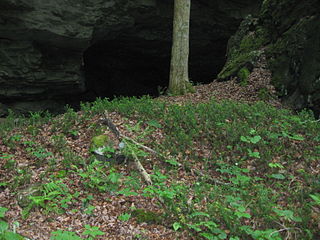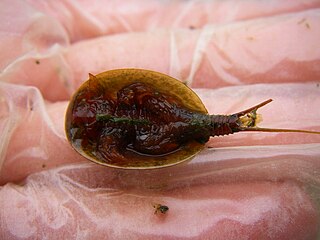
Mammoth Cave National Park is a national park in south-central Kentucky, encompassing portions of Mammoth Cave, the longest cave system known in the world. The park's 52,830 acres (21,380 ha) are located primarily in Edmonson County, with small areas extending eastward into Hart and Barren counties. The Green River runs through the park, with a tributary called the Nolin River feeding into the Green just inside the park.

Scouting in Kentucky has a long history, from the 1910s to the present day, serving thousands of youth in programs that suit the environment in which they live. Kentucky has a very early Scouting heritage, as the home state of Daniel Carter Beard.

The Green River is a 384-mile-long (618 km) tributary of the Ohio River that rises in Lincoln County in south central Kentucky. Tributaries of the Green River include the Barren River, the Nolin River, the Pond River and the Rough River. The river was named after Nathanael Greene, a general of the American Revolutionary War.

The Cradle of Humankind is a paleoanthropological site and is located about 50 km (31 mi) northwest of Johannesburg, South Africa, in the Gauteng province. Declared a World Heritage Site by UNESCO in 1999, the site is home to the largest concentration of human ancestral remains anywhere in the world. The site currently occupies 47,000 hectares (180 sq mi) and contains a complex system of limestone caves. The registered name of the site in the list of World Heritage Sites is Fossil Hominid Sites of South Africa.
Kingdom Come State Park is a part of Kentucky's state park system in Harlan County atop Pine Mountain near the city of Cumberland. It was named after the 1903 best-selling novel The Little Shepherd of Kingdom Come by native Kentuckian John Fox, Jr. Features of the park include Raven Rock, Log Rock, and a 3.5-acre (1.4 ha) mountain lake. The section of the park is also a legally dedicated state nature preserve by the Office of Kentucky Nature Preserves.

Carter Caves State Resort Park is located in Carter County, Kentucky, United States, along Tygarts Creek. It is formed by Carter Caves, and nearby Cascade Caves, which were added to the park in 1959. On December 16, 1981, 146 acres (59 ha) of the park were designated as nature preserves. Bat Cave and Cascade Caverns State Nature Preserves were dedicated for the protection of the Indiana bat, mountain maple, and Canada yew, all endangered species.
The Oligo-Nunk Cave System is a group of six caves in Kentucky, United States.

Bat Cave and Cascade Caverns State Nature Preserves are two nature preserves totaling 146 acres (0.59 km2) located within the boundaries of Carter Caves State Resort Park in Carter County, Kentucky, United States. Bat Cave was dedicated as part of the Office of Kentucky Nature Preserves system on December 16, 1981, for the protection of the Indiana bat with wintering numbers estimated at 28,000. The Cascade Caverns preserve was included to protect two rare plant species in Kentucky, the mountain maple and the Canadian yew.

Typhlichthys subterraneus, the southern cavefish, is a species of cavefish in the family Amblyopsidae endemic to karst regions of the eastern United States.
Caecidotea nickajackensis is a species of isopod crustacean in the family Asellidae. It was believed to be endemic to a single cave in Tennessee, and was thought to have been exterminated when that cave was flooded in 1967 by the building of the Nickajack Dam, however, in 2013 the species was discovered within Horseskull Cave and Raccoon Mountain Caverns.

Lepidurus packardi, the vernal pool tadpole shrimp, is a small, rare species of tadpole shrimp (Notostraca) found in temporary ponds of the western United States.
Eleven Jones Cave is located by Beargrass Creek in Louisville, Kentucky. It is 1,600 feet (490 m) southeast of the corner of Eastern Parkway and Poplar Level Road on the west bank, between Louisville Cemetery and Calvary Cemetery, near St. Xavier High School. It is developed in Louisville Limestone 448 feet above sea level. A spring discharges water into Beargrass Creek.
The Great Saltpetre Cave is a notable limestone cave located in Rockcastle County in southeastern Kentucky. During the War of 1812, it served as an important source of saltpeter, a vital component of gunpowder Also known as black powder.

The Tooth Cave ground beetle, Rhadine persephone, is an endemic beetle that lives only in karst caves in Texas. They are arthropods of the family Carabidae. The United States government considers these beetles endangered because they are only found in a single cave system. If these caves are destroyed, this beetle will likely go extinct. The cave system is currently threatened by pollution, urban development, and invasion by fire ants.
Pseudanophthalmus holsingeri, or Holsinger's cave beetle, is a species of ground beetle in the family Carabidae. It is endemic to Virginia in the United States.
Pseudanophthalmus tenuis is a species of ground beetle in the family Carabidae. It is endemic to Indiana in the United States.
Pseudanophthalmus hoffmani, or Hoffman's cave beetle, is a species of ground beetle in the family Carabidae. It is endemic to Virginia in the United States.
Guanyindong or Guanyin Cave is a Palaeolithic cave site, discovered in 1964 by archaeologist Pei Wenzhong in Qianxi County, Guizhou, China.
Orconectes packardi, the Appalachian cave crayfish, is a species of crayfish in the family Cambaridae. It is endemic to Kentucky, where it is found in 16 caves in four southeastern counties in the Cumberland River basin.









